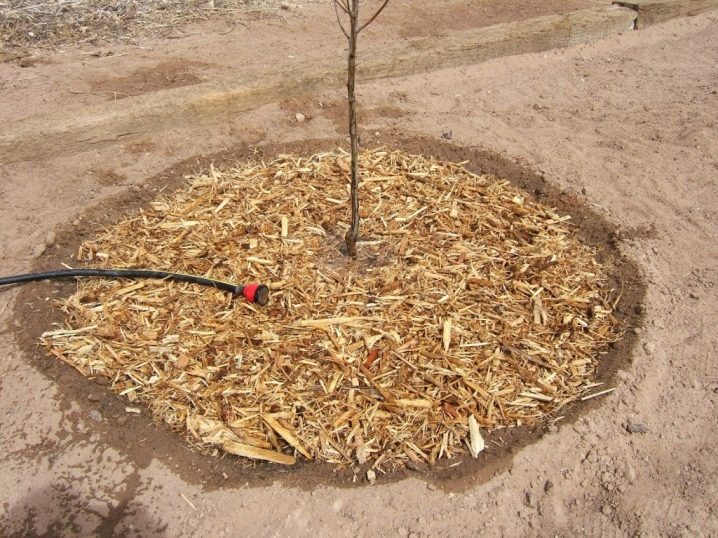Care and landing
The flower loves a lot of sun, but at the same time it can easily withstand light frosts. When choosing a landing site, care must be taken to protect it from strong winds. The soil for planting should be chosen light and rich in humus, with neutral acidity. Tulips Triumph, like other representatives of this culture, love abundant watering, but without stagnant moisture.
Bulbs are usually planted in early autumn, when the heat subsides and the outside is cool, but free from frost. The most comfortable landing conditions are at temperatures no higher than 10C - usually from mid-September to mid-October. This time is considered optimal for the best rooting of tulip bulbs.
Before disembarking, a backlog is being prepared. To do this, dig a hole 30-40 cm deep. Dry sand is poured at the bottom of the hole, then a layer of compost or humus is laid out. It is strictly forbidden to bring fresh manure into the hole - it can "burn" the plant. After the onion is placed in the hole, you can sprinkle it with another layer of sand and cover it with earth on top, water it abundantly.
Tulips are usually not covered for the winter, but if there are early frosts, you can sprinkle them with a layer of dry leaves. In early spring, immediately after the snow melts, the planting site must be loosened and fertilized with ammonium nitrate, and when the buds are tied up, it must be fed with mineral fertilizers. The standard set is nitrogen, phosphorus and potassium.
The flowering period begins when the outdoor temperature is stable at 18–20C, and continues until the end of May. At the end of June or early July, the leaves on the plants begin to dry, and this is a sure sign that it is time to dig up the bulbs. All specimens are carefully examined, the damaged ones are removed, and the healthy ones are dried in a dark place for two weeks at a temperature of 20-25C. Then they are cleaned of husks and old growths and removed for storage in a dark, dry place, away from mice and other rodents.
The main varieties of tulips of the "Triumph" class
Fun for two. This variety has a large bud 5-7 cm high and 4-5 cm in diameter. The height of the whole flower is 40 cm. The bulb divides well for reproduction, subsequently giving an excellent harvest. The color of the bud is white, with a subtle yellowish tinge.
The Triumph class is the most numerous. The varieties of this series account for almost a quarter of all tulip varieties known today. Representatives of the class grow in all corners of the world, including in our country, in particular in the Yalta Botanical Garden, in the Sochi arboretum, and also decorate the flower beds of many Russian cities not only in the south of the country, but also in central Russia.
For information on how to properly care for tulips, see the next video.
The best varieties of Kaufman tulips
Class 12. Kaufman tulips, varieties and hybrids.
It was separated into an independent class in 1960. The varieties are distinguished by early flowering periods, a variety of colors, and resistance to variegation virus. The flowers are cupped or star-shaped.
Greig's tulip hybrids have speckled leaves. In the class there are 2.9% of varieties of the entire assortment.
Table "Kaufman tulip varieties":
| Variety name | Breeder, year of registration |
Plant height, cm |
Flower color |
Flowering period |
| Ancilla | Tubergen, 1955 |
20 |
Rose red with yellow border |
OR |
| Gluck | Tubergen, 1940 |
25 |
Carmine red. Inside
bright yellow |
OR |
| Johann Strauss | Tubergen, 1966 |
25 |
Outside red with white border, inside white |
OR |
| Corona | Tubergen, 1948 |
25 |
Red, bright golden inside |
OR |
| Scarlet Baby
(Scarlet Baby) |
J.C. van der Meer, 1962 |
20 |
Geranium outside, scarlet red inside |
OR |
| Earley Harvest
(Early Harvest) |
Rijnveld & Sons, 1966 |
25 |
Outside red with a slight orange border.
Inside, it is orange with a reddish shading, intensifying from top to bottom. |
OR |
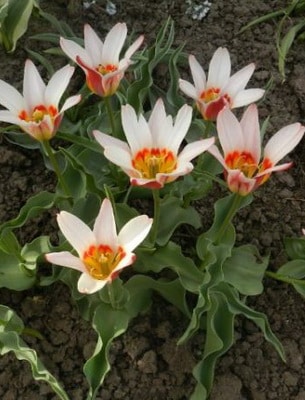

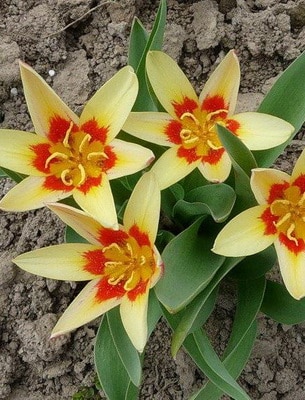

Botanical and hybrid species of Tiarella
In total, several studied botanical species of Tiarella are known, many of them are used in horticultural floriculture. The most popular variety is Tyarella cordifolia, which includes many natural and hybrid varieties. This species has become widespread as a garden culture due to its high frost resistance. In the wild, perennial evergreen bushes are found in Scotland and Alabama. The plant reaches a height of 20 cm, forming a large herbaceous spherical shrub. The leaves of cordial tiarella are round, cordate. Young tendrils are formed on the shoots, which allow the plant to grow rapidly in breadth. On the leaf surface, clear streaks of bronze or golden color can be noted. The buds are collected in very large racemose inflorescences. The perennial blooms profusely and for a long time - up to 30 days from May. The following interesting varieties of tiarella cordifolia are known in horticulture: Albiflora - white flowers, collected in numerous brushes
Iron Butterfly - large pinnately dissected foliage of rich green color with snow-white flowers in erect racemes
Spring Symphony - profusely long flowering
Appalachian - reaches 15 cm in height, bush diameter up to 90 cm, can be grown as an ampelous potted perennial
Pink Skyrocket - reaches 30 cm in height, pale pink inflorescences of star-shaped flowers
Silverado is a dwarf, up to 25-30 cm tall, bush diameter 20-25 cm
The heart-leaved hybrid thiarella is a verry variety. In Russian floriculture, it is used either as an annual or does not occur at all. It is actively cultivated in the gardens of the Southeastern part of North America. It is very similar in leaves and flowers to the previous described species, but it does not bloom so abundantly and is less winter-hardy. The flowers of the plant are white or pink. The most famous varieties of tiarella: Dark Eyes - dark purple areas are found in certain parts of the green leaf
Tiger Stripe - decorative foliage
Ninja - the leaf blade is dissected into several cirrus lobes with dark veins
Pink Bouquet is an abundant long-lasting bloom. Look at the variety in the photo of tiarella below:
Even less often, three-leafed thiarella, a perennial found in areas of North America, is grown in gardens. In this variety, the flowering stem can reach from 10 to 80 cm in height. The leaves are collected in a root rosette. On the stem there are more often 1-4 leaves or one single plate, up to 10-15 cm long. Flowers are collected in paniculate loose inflorescences. The fruit is a capsule.
One-leaved tiarella pleases with beautiful varieties - a large perennial plant, up to 50 cm high. In its natural environment, it is found in Canada and Alaska. Among botanical varieties for horticulture, the following are used: Starburst - frost-resistant variety with early flowering
Sea Foam - leaves are large, pinnately dissected
Cygnet - the leaf plate looks like a flying swan
Black Velvet is a very fast growing hybrid. Flowers are white or pink in clusters. There is a noticeable black and purple pattern on the leaves.
Description and characteristics of the variety
- indeterminate growth of the main stem (the shoot grows up to 3-3.5 m in height);
- lateral branches are weak, thin, need to be pinched after 2-3 leaves;
- the root system is developed, superficial;
- mixed flowering - for 2 female flowers there is 1 male.
Gardeners are interested in the question: is the Chinese snake self-pollinated or not? The hybrid is a parthenocarpic with a mixed type, pollinated independently without the attraction of insects.
The visiting card of the variety is presentable fruits, among their characteristics:
- length varies within 40-50 cm, with outgrowth it reaches 1 m;
- elongated cylindrical shape;
- diameter 5-6 cm;
- weight 300-400 g;
- the skin is tender;
- low-seeded pulp (seed chambers are rudimentary), crispy;
- the color is bright green;
- tubercles are small, sparse;
- classic taste, balanced with notes of sweetness.
The crop is harvested when the length of the fruit is up to 40-45 cm. When overgrown, the consistency becomes fibrous and harsh, notes of bitterness appear.
Peonies after flowering
After the flowering period has passed, the plant is fertilized. Despite the lack of buds, the bushes do not lose their attractiveness due to the large number of leaves.
Transfer
Repotting for the purpose of reproduction is recommended in the fall after the flowering period or in early spring. If the last option is chosen, then you can divide the bush until it has red shoots reaching a height of 15-20 cm.
If the bush needs to be transplanted to another place without dividing, this can be done in the summer.
Pruning
Experienced flower growers recommend periodically cutting off the buds that have already faded. This stimulates further flowering.
Preparing for winter
In late autumn, the stems of flowers are cut, leaving columns no higher than 3-5 cm.In areas with cold winters peony Ito hybrid Canary Diamond cover with spruce branches or sawdust.
Additional Information! Plants should not be covered with foil for the winter. Due to the greenhouse effect, the rhizomes and aerial parts rot.
Tulips of the Triumph class: photo, description and flowering period of varieties
Class 3. Triumph tulips.
Bred at the beginning of the 20th century by crossing varieties from the Darwin tulip class with varieties from the Simple early class. They are characterized by a rather high peduncle, a large goblet flower, and a good breeding rate.
Table "Description of varieties of tulips of the Triumph class":
| Tulip varieties of the Triumph class | Breeder, year of registration |
Plant height, cm |
Flower color |
Flowering period |
| Aastere | V. Skuya, 1992 |
55 |
Raspberry |
WITH |
| Abu Hassan | J. F. van den Berg & Sons, S. Digs & Sons, 1976 |
50 |
Brown red with
golden border |
WITH |
| Abra | Hybrid, 1959 |
40 |
Mahogany with yellow border |
WITH |
| Atlantis | J.F. van den Berg & Sons, 1981 |
60 |
Lilac-purple with wide
white border |
WITH |
| Atraitnes Dels | V. Skuya, 1992 |
55 |
Cardinal with white border |
WITH |
| African Queen | J. Ligthart, 1983 |
60 |
Maroon with a narrow white border |
WITH |
| Barcelona (Barcelona) | Hybris, 1989 |
60 |
Fuchsin-purple |
WITH |
| Gavota | Vaclavik, Tsebeko, 1995 |
50 |
Dark cherry with bluish
bloom and wide yellow border |
WITH |
| Gander | Zegers, 1952 |
60 |
Bright fuchsin red |
WITH |
| Gene. Kohler (General Kohler) | Van den Berg, 1989 |
50 |
Pink with white-pink border |
WITH |
| Herman Boerhaave | Zandworth, 1986 |
60 |
Blue-violet with white border |
with |
| Grevel (G revel) | K. Outen, 1969 |
50 |
Pearl pink with white border |
with |
| Guus Papendreht | Snoek, 1989 |
45 |
Red with white border |
with |
| Dix 'Faourite | Kavelaars, 1952 |
50 |
Bright red |
with |
| Cantor | Coliin and Sons, 1960 |
55 |
Coral pink |
with |
| Kees Nelis | X. Mannetier, 1951 |
40 |
Red with golden border |
with |
| Korida | V. Skuya, 1992 |
60 |
Dark coral |
with |
| Leo Visser | P.J. Nice, Boots, 1992 |
50 |
Raspberry with white border |
with |
| Liberty Spring | V. Skuya, 1992 |
55 |
White with a wide pink border |
with |
| Leen van der Mark | Koninenburg and Mark, 1968 |
50 |
Red with creamy white border |
with |
| Lustige Battle (Lustige Witwe) | Sons of H. van der Mei,
1942 |
45 |
Burgundy red with white border |
with |
| Martina | J. Penning, 1997 |
60 |
Raspberry with creamy yellow
border |
with |
| Negrita | Beek, Jacques Tol, 1970 |
55 |
Bright purple |
WITH |
| Noslepums | V. Skuya, 1992 |
55 |
Brown with narrow white
border |
WITH |
| New Design | Jacques Tol, 1974 |
55 |
Creamy yellow with pink fuchsin border |
WITH |
| Princess Victoria | J.F. van den Berg & Sons,
Van den Berg - Yokohama, 1979 |
50 |
Rhodonite-red with narrow
white border |
with |
| Red Bouquet | Koninenburg and Mark, 1984 |
40 |
Rhodonite-red |
with |
| Recreado | Visser, 1979 |
50 |
Dark violet |
with |
| Ruja | V. Skuya, 1992 |
60 |
Lilac purple with orange border |
with |
| Sabile | V. Skuya, 1992 |
55 |
Red crimson with white border |
with |
| Santina | I VT, T. Timmerman,
1982 |
45 |
The outside is burgundy red with a white border.
Red inside with white striated border. |
with |
| Solveiga | V. Skuya, 1992 |
55 |
Lilac with a lighter border |
with |
| Stargazer | Hybris, 1991 |
45 |
Dark red with white border |
with |
| Strong Gold | J.F. van den Berg and son,
J.A.Boret and son, 1989 |
50 |
Flowers of this variety of tulips of the Triumph class have a yellow color |
with |
| Taizels | V. Skuya, 1992 |
60 |
Dark lilac with a lighter border |
WITH |
| Tamara | Visser, 1979 |
55 |
White with rich pink border |
WITH |
| Trendsetter | Visser, 1983 |
50 |
Tomato red flame with lemon border |
WITH |
| White Dream | J.F. van den Berg & Sons,
J.A. Boret, 1972 |
50 |
White |
with |
| White Swallow | Beek, Jacques Tol, 1975 |
55 |
Ivory, white at the end of flowering |
with |
| Shanson | Vaclavik, 1994 |
50 |
Plum with white border |
with |
| Shirley | Beek, Jacques Tol, 1968 |
50 |
Ivory with narrow striated border
magenta |
with |
See how beautiful the varieties of tulips of the Triumph class are in these photos:



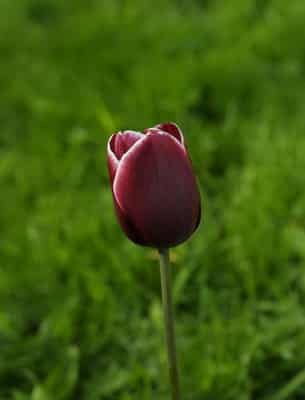
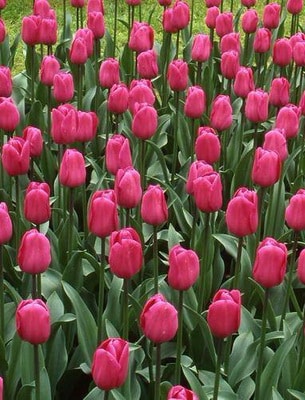
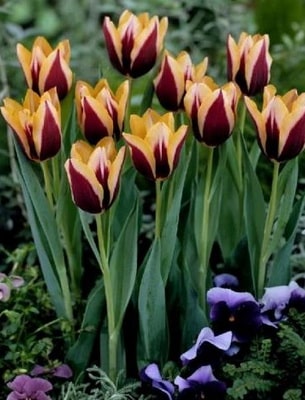

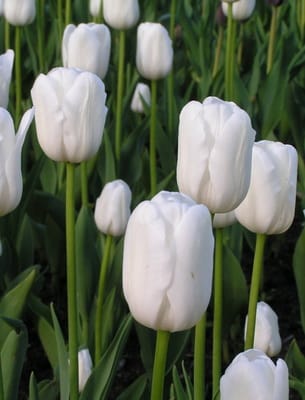

Spruce variety description
The Fat Albert coniferous tree adjoins a group of spruces with a wide conical shape and special proportionality, it grows extremely rapidly - up to 20 cm per year. Mature trees of this species reach 15 meters in height and 3-4 meters in diameter. At the age of 10, the spruce grows up to 3 meters.
Characteristic features of an evergreen, or rather, an evergreen plant:
- strong and durable, densely growing branches located perpendicular to the trunk indicate the tiered structure of the tree;
- sharp, prickly needles of the needles reach 2-3 cm in length and are distinguished by a blue tint that does not fade throughout the year;
- cones that form in spring are oblong, sometimes ovoid, have a violet-green color and look beautiful on gray twigs, over time they will turn brown.

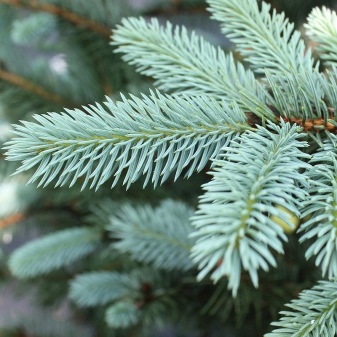
Other characteristics of this coniferous culture:
- has increased winter hardiness and withstands sub-zero temperatures below -35 degrees;
- loves light, is quite resistant to an arid climate, but, growing in it, grows much more slowly;
- feels good on fertile, loose soils with good drainage;
- with strong moisture, the spruce is susceptible to the influence of fungal microorganisms, its branches wither and can crumble;
- the branches of the plant can withstand high loads, so they are not afraid of the abundance of snow.
- "Fat Albert" can get sick only due to improper irrigation, strong soil acidity, stagnation of moisture in the soil.
The tree is not susceptible to pests and feels great in urban conditions - the impact of gassed air, pollution and the presence of smoke in the atmosphere does not actually affect its vitality and beauty. Thorny Christmas tree "Fat Albert" is rightfully considered one of the best types of blue spruce and is a worthy decoration of private and public territories.
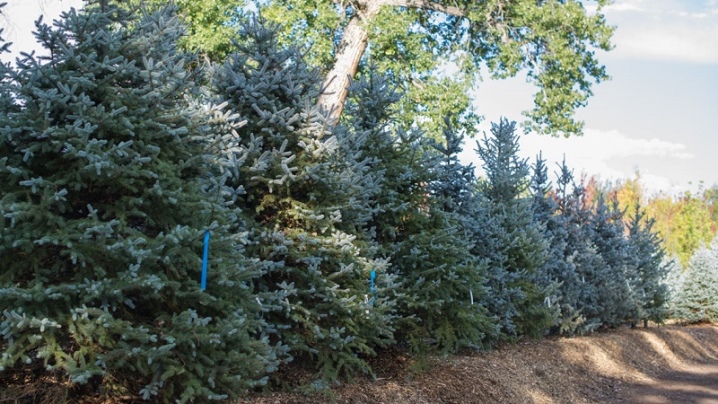
Description
The first successful experience of growing liriodendron in the Russian Empire dates back to 1813 and is associated with the activities of the Nikitsky Botanical Garden, located on the southern coast of Crimea. Now the tree in question can be found both in the gentle subtropics of the Krasnodar Territory, and in the more severe regions of the middle zone and the Black Earth Region. Let's highlight the main features of the described plant.
Great height, reaching 30-60 meters, depending on the species, and rapid growth (vertical - up to 1 m per year, horizontal - up to 20 cm).
Beautiful leaves, the shape of which resembles a lyre. As a rule, they consist of 4 blades, and their dimensions are 8-22 cm and 6-25 cm in length and width, respectively.
Most often, the leaves of young liriodendrons are larger and indented than those of adult trees.
Bisexual single flowers, resembling a tulip in appearance, capable of reaching 10 cm in diameter and attracting attention with their greenish-yellow color (orange blotches are also characteristic of the American species).
Pineal fruit of medium size, consisting of lionfish, inside which are 4-sided seeds.
Powerful trunk covered with greenish-gray bark. In the first years of a tree's life, it is smooth, but over time, cracks form on its surface, forming embossed diamond-shaped areas
On the branches, the bark looks different, characterized by a brownish tint and the presence of a waxy coating.
Light wood, successfully used for the manufacture of musical instruments and quality plywood.
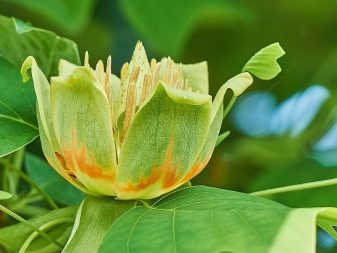
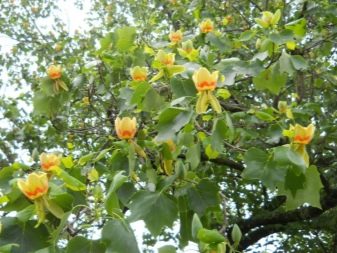
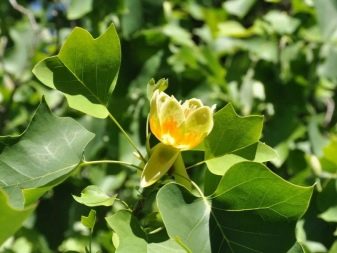
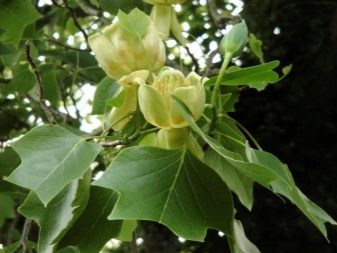
Diseases and pests of apricot and how to deal with them
Triumph North is resistant to the main diseases and pests inherent in apricots. However, one should not neglect the complex of preventive measures carried out for all plants in the garden.
Such events consist of the following simple actions:
- Collection and destruction of fallen leaves. It is better not to use it for compost, since it almost certainly contains fungal spores, insect larvae, mites, etc. Many of them are likely to survive composting.
- Sanitary pruning as described above. Cut diseased and dry branches are also burned. As a result of these 2 activities, a valuable fertilizer will be obtained - ash.
- Some larvae, beetles and ticks hide for wintering in the upper layers of the soil of the near-trunk circles, and there may also be spores of fungi. If you dig the soil under the tree in late autumn, all these guests will be lifted up and die from the frost.
- Autumn whitewashing of boles and skeletal branches with lime will protect from spring burns, block the path to the crown of caterpillars, beetles, ants, carrying aphids to young leaves.
- Whitewashing is not enough to stop insects. Trapping belts installed on the lower part of the trunks can help in the fight against them.
- The autumn tying of trunks with roofing material will prevent hares from nibbling the bark.
- Some pests and pathogens overwinter in the cracks of the tree bark. This is especially true for older apricots. It is necessary to clean out the dead layers of the bark and treat this place with a 3% solution of copper or iron sulfate. This procedure is carried out twice - in late autumn and early spring, during the absence of sap flow.
- In early spring, preventive treatment with fungicides (preparations for fungal diseases) and insecticides (means for controlling insects) is carried out. There are universal preparations that combine both fungicidal and insecticidal properties - these are DNOC (they can treat plants no more than 1 time in 3 years), Nitrafen and some others.
Probable diseases of apricot Triumph north
Triumph of the North is resistant to diseases such as coccomycosis. Moniliosis is a more likely enemy. Most often, spores of the fungus, which is the causative agent of moniliosis, are brought in by bees collecting nectar during the flowering period.

In spring, moniliosis affects flowers, leaves and shoots.
If favorable conditions arose for the development of a fungus in the summer, it can once again manifest itself, but already as a fruit rot that affects berries. The difference from other types of fruit rot is the chaotic arrangement of black dots on the surface of the fruit.

The first signs of moniliosis on apricot fruits are black dots.
Clasterosporium is a perforated spot. This is also a fungal disease that appears with high humidity.
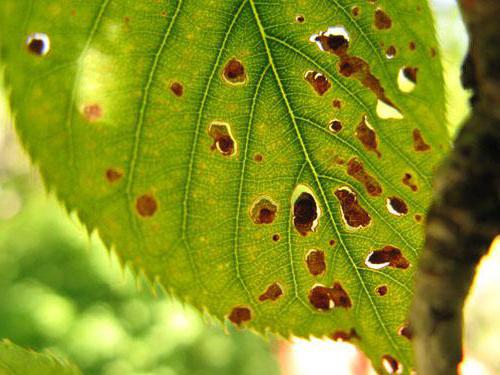
As soon as characteristic red-burgundy dots are found on the apricot leaves, you need to immediately start treatment against clasterosporium
Potential pests of apricot Triumph north
It happens that pests attack the apricot, which can cause significant damage to the crop and even harm the tree itself:
-
Weevils. They hibernate in the bark, fallen leaves and the upper layers of the soil. In the spring, waking up, they climb the trunk and satisfy their hunger. Then eggs are laid in the soil, from which larvae creep out in summer, feeding on young roots.
-
Khrushchev. These are the larvae of beetles, including May beetles, which feed on young roots in the upper layers of the soil in summer.
-
Aphid. If in the first half of summer leaves began to curl on the apricot, you need to pluck such a leaf and unfold it. Most likely, there will be aphids, which feed on juicy leaves and produce the sweet mucus that ants love so much. It is they who carry these little pests on their shoulders up into the crown of the tree.
Selection Tips
Florists and gardeners, in the process of choosing hosts for the cultivation of a particular species or variety, first of all take into account personal preferences. However, in order to acquire a really suitable plant for decorating the territory, you should adhere to the following recommendations
- A novice or experienced florist, landscape designer should know that the adaptation process takes place fastest in tall and medium-sized host varieties. This is due to their resistance to external factors and immunity to many ailments.
- If you plan to plant dwarf or miniature hosts in the open field, then in terms of agricultural technology, you should prepare for the fact that plants may require the creation of certain conditions on the site, in addition, such crops are at times more likely to suffer from attacks of insect pests and various ailments. Small species and varieties are recommended to be purchased for growing in rose gardens. With the help of such plants, you can decorate slopes, create alpine slides, and they can also be used as a ground cover.
- As for the choice of a host for flowering flower beds, then for joint planting with hydrangea, spirea or astilba, you can use any hosts of suitable color. The culture also develops well together with tall shrubs or trees.
- For planting in open areas, the host in pots, flowerpots or other containers is suitable only for low varieties. Such mobile flower beds can become a real decoration, which, if necessary, can be transferred to another part of the garden.
- Giant hosts should be considered for purchase only if there is enough space for culture in the garden.
For the types and varieties of hosts, see the next video.
Varieties and types of hosts with photos and names
Let's briefly present the host varieties with photos and names. The culture is widely used in the design of the landscape area, due to the variety of species. The breeding work has borne fruit. Now there are more than 4 thousand hybrid hosta varieties. Several species were taken as a basis, which laid the foundation for varietal diversity.
Bloated Hosta Ventricosa photo in the garden
Up to 0.5 m high, the leaves are pointed at the end, for example, the Thomas Hogg variety.
Wavy host Hosta undulata
Hosta undulata wavy in landscape design photo
Reaches 75 cm in height, its leaf blade has a wavy edge, a white center and a green border, as if applied by strokes. An example is the host Undulata Mediovariegata.
High Hosta Hosta elata Hylanger
High Hosta Nosta elata Hylanger photo
It grows up to 0.9-1 meter, its rather large glossy leaves cast a dark green color. A typical representative is the Tom Schmid cultivar.
Hosta Siebold Hosta sieboldiana
Hosta Siebold Hosta sieboldiana variety Elegans photo
60 centimeters high, has deep veins. Elegans variety.
Curly Hosta Hosta crispula
Curly hosta Hosta crispula cultivar ‘Thomas-Hoog’ photo
Rarely exceeds 0.5-0.6 m in height, with wide dark green leaves bordered by a white stripe. An example is the Dream Weaver cultivar.
Plantain hosta Hosta plantaginea
Plantain hosta Hosta plantaginea photo
Half a meter in height, has bright glossy green leaves. Royal Standard grade.
Hosta fortunei
Hosta Fortunei Hosta ‘Fortunei Aureomarginata’ photo
Also, it does not grow more than 0.5 meters, it has green leaves with a cream edging. For example, the host variety albopict.
Depending on the color of the leaf plate, the varieties are conventionally divided into 5 groups:
- Blue hosta (blue hosta (B)) - its leaves with a bluish-gray tint.
- Yellow host (Go) - yellow-leaved.
- Green host (Gr) - has combined the entire green-leaved host.
- Hosta variegata (V) - varieties with variegated leaves and all those that have a white border.
- Hosta Mediovariety (MV) - light-leaved varieties with a green border around the edge.
By plant height (size), the division goes into the following 6 groups:
- Dwarf group Draft (D), unites all species below 10 cm, such as Blue Mouse Ears with bluish leaves resembling mouse ears.
- Hosta is miniature, Miniature (Mini), its height is within 10-15 cm, for example, La Donna variety with bluish-yellow-green leaves.
- Small Hosta Small (S) with a maximum height of 16-25 cm, examples are Gold Tone with green leaves and stripes of white or yellow, and Headsmen Blue with bluish green leaves.
- Medium hosta Medium (M, Med), growing up to 30-50 cm in height, its representatives are the following varieties: Night Before Christmas, with a white center and a dark green wide stripe along the edge, So Sweet, its green leaves are bordered white and cream stripe, White Feather is a unique host of white color, which changes its color to green after a certain amount of time.
- A group of large hosts Large (L), reaching a height of 0.5-0.7 m, is represented by varieties: Alvatine Taylor, in which a yellow-green border runs along its bluish-green leaves, Golden Meadows with crushed rounded golden leaves in the middle, dotted with pale green strokes and bordered by a wide green stripe.
- Giant hosts Giant (G), over 70 cm tall, for example, Blue Vision with greenish-bluish leaves and Sum of All, which has a green center of the leaf and a wide, golden border.
Growing and care
Agricultural engineering is carried out in standard ways. The main care consists of watering, feeding, preventive measures.
Watering
The beds are watered regularly with warm water (due to cold watering, rot and oversporosis are possible). In order for moisture to flow evenly to the roots, drip irrigation or sprinkling is used, irrigation nozzles are used.
The frequency of moistening is 4-5 times a week, in the midst of the heat it is watered daily. To protect from the bright sun, corn and climbing crops are planted on the south side of the garden for shading.
Fertilizer
Bushes need constant feeding, which is carried out at least 5 times per season. Seedlings are fertilized at the 2-leaf stage and after 2 weeks. Use nitrophosphate, Breadwinner, Ideal.
After disembarking to a permanent place, they are fed after 7-10 days. A bread infusion is prepared: the crusts are soaked in water to a state of gruel, diluted 1 to 5.
The multiplicity of dressings in the beds is 1 time in 10-14 days.
To saturate with nitrogen, use urea (1 tablespoon per 10 liters), diluted solutions of dung and mullein.
Of the minerals used:
- nitrophosphate;
- superphosphate;
- potassium sulfate;
- ammonium nitrate.
Of the complex preparations, Agricola, Vegetable Aelita give a remarkable effect.
Agro experts advise alternating organic and mineral fertilizing.
Pest control
Plants are infrequently attacked by insects. Of the pests, the danger can be
- aphid;
- whitefly;
- thrips.
For the treatment of bushes, a solution is prepared from onion husks and soap. The caterpillars are harvested by hand. For the fight, Profi, Aktofit are used.
Sick and damaged leaves without hemp are cut off.
The cucumber on the windowsill is grown according to the general rules; stem supports are placed in a pot for a garter. Provide daylight hours up to 15-17 hours a day (use phyto-lamps).
Pests and diseases
An autumn well-groomed maple tree in the garden is a fascinating picture, but it will cease to please the eye if the tree gets sick. Powdery mildew is the most common maple disease that can cause it to dry out. It appears as a white bloom on the leaves. To cure a tree, you need to remove the infected shoots, treat the wounds with garden varnish and disinfect them. Another method of struggle is prophylactic spraying of maple with antifungal agents (fungicides) or copper sulfate.
The next attack is black spot. It affects the leaves, protruding on them with dark spots. The tree loses its decorative qualities. They fight it in the same ways as with powdery mildew.
The plant also has enough pests. Weevils, whiteflies, mealybugs and other insects can seriously harm the tree. The main way in the fight against this scourge is spraying with insectoacaricides (familiarity with the instructions and compliance with safety rules are mandatory).If the infection occurred in the fall, then the leaves are destroyed.
For an overview of the Japanese decorative red maple, see the following video.
The nuances of growing
Spring is the time of awakening. After the snow melts and the shoots appear, debris should be removed. Then you need to water the flower with an aqueous solution of potassium permanganate. For 5 liters, take 1.5 grams of the substance. This amount is enough to water one plant. After the procedure, it is necessary to loosen the soil and mulch it.
Summer is the time for flowering. Young plants are already forming buds. It is believed that it is better to cut them off in the first year. This allows the plant to retain strength for further development and more abundant flowering next year.
Young bushes do not need feeding. As for adult specimens, it is advisable to fertilize them.
Each bush has 1.5 buckets. Water the plants once a decade
When watering, it is important to take into account that moisture should not fall on the leaves, but strictly under the root. And you should also regularly loosen the soil near the flower, especially after rains.
After flowering, it is important to monitor the condition of the plants, to continue watering, loosening, weeding, and the introduction of nutrients. New plants are planted in autumn
Old bushes are transplanted if necessary (as already mentioned, it is not necessary to do this annually). If the flower remains in the same place, it is freed from dry foliage. In addition, bad stems are pruned, which are then burned. The remaining healthy parts of the culture are treated with ash.
With the arrival of frost, the flowers are cut off. Shelter is provided for juvenile specimens.
Care rules
In order to grow a healthy and beautiful tulip tree, it is essential to take proper care of it. This task is not particularly difficult, and therefore any gardener, both experienced and beginner, can cope with it.
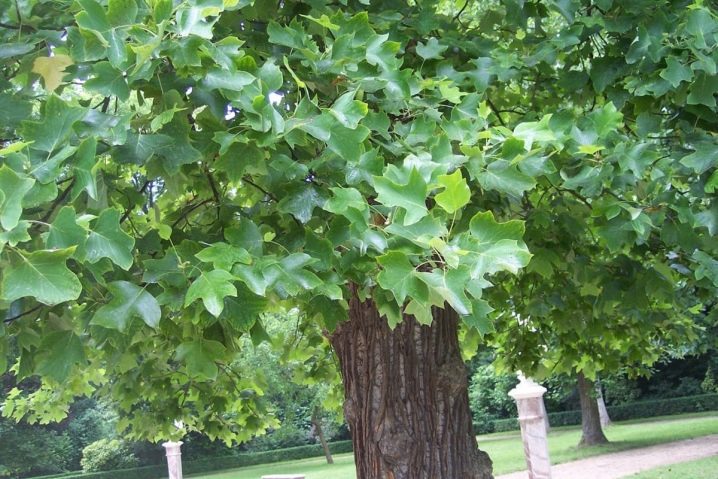
Watering
Optimal watering of the liriodendron should provide for regular, but not excessive moisture in the soil, which is especially important in the first years of the tree's life. It is also desirable that the water used is at room temperature (approximately + 20.25 ° C). Another procedure that contributes to the development of the described plant is spraying the crown in the warm season. It should be carried out every day, several hours before sunset, using a garden hose with a special sprinkler nozzle.
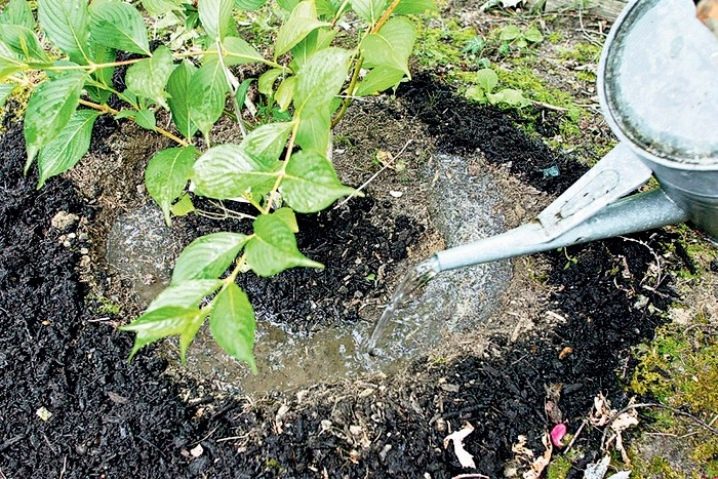
Fertilization
The first feeding of a tulip tree can be carried out after two years from the moment of planting. This procedure is performed in early spring and involves the use of nitrogen-containing preparations that act as a stimulant for leaf growth. The second feeding is carried out at the end of the growing season and involves the use of potassium-phosphorus fertilizers. Such compositions strengthen the root system of the plant, as well as increase its resistance to diseases and adverse weather conditions.

Preparing for winter
Given the frost resistance of the tree in question, it can be argued that only young liriodendrons need a full-fledged shelter for the winter. To solve this problem, it is enough to follow a few simple steps, namely:
mulch the tree trunk circle with sawdust or peat (the recommended layer thickness is 10 cm);
carefully press the branches of the tree to the trunk, wrap them in burlap and tie them with a rope for secure fixation;
as additional protection from the cold, you can use spruce branches located around the plant.
